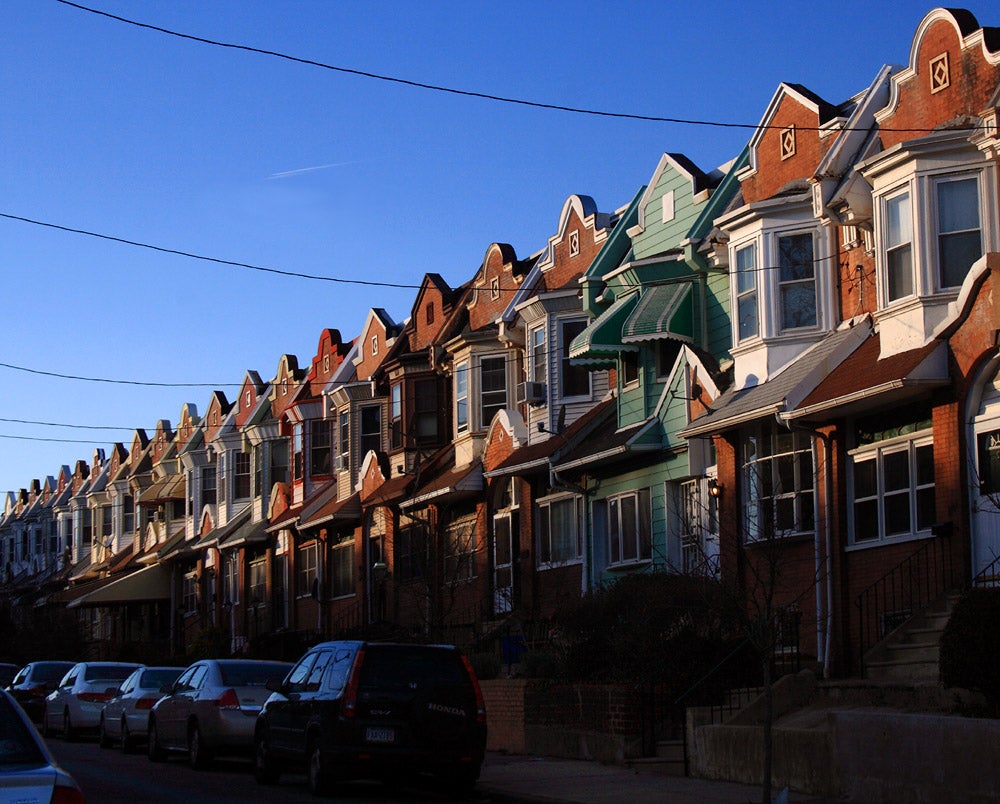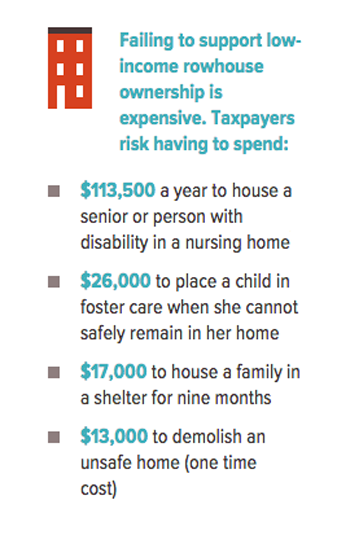Housing policy in Philadelphia: We can do better

In this op-ed architect and Design Advocacy Group chair Kiki Bolender makes the case for rowhouse preservation programs as a way to improve resident health and well-being while stabilizing rowhouse blocks. The Design Advocacy Group is leading the Healthy Rowhouse Project and the issue of healthy houses is also a plank in this year’s Next Great City platform.
How many times have you heard Philadelphia described as a city of neighborhoods? We have a huge affordable housing asset in our blocks and blocks of rowhouses. But many of those homes are deteriorating and their owners have to make choices between buying food or fixing the roof. In 2012, 38% of homeowner households earned less than $35,000 a year. Leaky roofs and the mold and dampness that follow are making the residents sick. Asthma in particular is a fast growing public health problem, and dozens of studies have shown how the conditions inside a house are inextricably linked to the health of the residents.
The Healthy Rowhouse Project advocates for repair and preservation of existing occupied houses as a key part of housing policy under the next administration. This coalition of design and health professionals seeks to reduce blight, abandonment and homelessness. The focus is on the rowhouse because it is Philly’s iconic building type. And focusing on repairs to one building type will help us get the repairs up to scale. So….why now?
NEIGHBORHOODS NEED HELP
A deteriorated house hurts all of the properties around it, spreading water damage and vermin, and removing building owners’ motivation to invest in their buildings. Our neighborhoods have lost thousands of affordable homes to abandonment over the past sixty years. Vacant and abandoned properties blight neighborhoods, take away hope, and thwart the good work in affordable housing by non-profits and private developers. Now that Philadelphia is growing again there is no reason to lose more.
RISING PROPERTY VALUES SUPPORT INVESTMENT

The median value of a single-family house sold in Philadelphia increased by 22 percent citywide from 2004 to 2014.
Rising property values create enough home equity in many Philadelphia neighborhoods to allow a property owner to finance repairs with a low interest loan or a deferred loan due upon sale of the house, and still make a profit when they opt to sell. Rising values make many financing tools viable, allowing thousands more houses to receive assistance each year through a mix of grants to the poorest owners and loans to those with developing equity in their houses.
In Philadelphia the lowest income residents are often renters. In Chicago, a non-profit Community Development Financial Institution (CDFI), has created a $415 million loan pool for multifamily rehabilitation through commitments from investor banks. Over the last 30 years, they made 1,900 loans for $1.1 billion and rehabilitated almost 50,000 units of affordable rental housing for more than 125,000 people. It worked so well that the group, the Community Investment Corporation, was awarded the 2012 MacArthur Award for Creative and Effective Institutions.
WHAT DOES THIS HAVE TO DO WITH HEALTH CARE IN 2015?
Medicare puts limits on hospital readmissions for recurring illness and Medicaid will soon follow, in an effort to get at root causes and not just treat symptoms as encouraged in the Affordable Care Act. But we hear from health and social service workers who go into homes in low-income neighborhoods, that they see conditions that they know are unhealthy for their clients, and don’t have anywhere to guide people to get help with their houses.
Housing and health is a hot issue, and major national foundations are interested. If Philadelphia has the right programs in place – contractors on board, trained apprentices from the neighborhoods, trusted partners in place – money is there to start a revolving fund to help more and more people.
QUOTING STING AND THE PROPHET AMOS
We’re not talking rocket science, or even advanced environmental science here. We’re talking roof repair, storm windows, fixing the furnace and making people healthier. We know when homes are healthier adults are more able to hold down a job, children are more successful in school, and neighborhoods rebound. The biggest challenge is to bring building repair to scale and really make a difference – which will take strong leadership from the Mayor and City Council.
Currently there is a waiting list of more than 6,500 homeowners for the Basic Systems Repair Program run by the City. We have to do better. We have to make the policy link between good housing and good health – one house at a time until we reach thousands. It’s not glamorous photo-op type work, but it is essential work. To quote the philosopher Sting, “All it takes is the doing of it”.
Likewise, quoting the prophet Amos, “But let justice roll down like waters, and righteousness like an everflowing stream.” Before that, Amos says (in a loose translation), “I despise your festivals, and I take no delight in your solemn assemblies….I want no part of your fatted calves, your harps, your Power Points, your ribbon cuttings, your photo ops, your posturing. Just fix the damn roof.”
WHYY is your source for fact-based, in-depth journalism and information. As a nonprofit organization, we rely on financial support from readers like you. Please give today.




